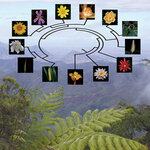Ecology & Zoology

Mauve Majesty is one cool lily look-alike. This new pinkish-purple ornamental flower, just patented by Cornell, can last for two weeks in a vase, but when left in the garden, it blooms all summer long in the cooler, northern states until the first hard freeze in the fall.
The new hybrid of the Inca lily (Alstroemeria), which was developed by a Cornell professor, is a non-fragrant perennial that is set apart by its lavender-lilac flower color (which is adorned with dark speckling and a creamy yellow throat), its strong, upright flower stems and its winter hardiness. In greenhouses, the new…

When it comes to choosing a place to live, male chimpanzees in the wild don’t stray far from home, according to a new report in the Dec. 27th Current Biology, a publication of Cell Press. The researchers found that adult male chimps out on their own tend to follow in their mother’s footsteps, spending their days in the same familiar haunts where they grew up. Male chimpanzees are generally very social, but how they use space when they are alone might be critical to their survival, the researchers said.
“We have found that, like females, male chimpanzees have distinct core areas in which they…

This is one of my undergraduate assignment under department of Agronomy, Sher-e-Bangla Agricultural University, Dhaka-1207, Bangladesh. Abstract
Wheat is the most important cereal crop of the world. Wheat grows well in different region in Bangladesh. Wheat cultivation is greatly affected by sowing depth. Sowing depth significantly influenced the seedling emergence and vigor index. Sowing seed deeper than 4 cm delayed & reduced seedling emergence & seed production. Seed placed at 8 cm depth resulted a greater degree (82%) of failure in emergence. Sowing at variable depths causes…

At present, biodiesel can play vital role in the transport sector all over the world. Biodiesel refers to a diesel-equivalent processed fuel derived from biological sources; especially plant species such as oil seed rape, jatropha, sunflower, soybean etc. I will discuss some prospective uses of biodiesel use in different vehicles.
History of Biodiesel
The concept of biofuels is surprisingly old. Rudolf Diesel, whose invention now bears his name, had envisioned vegetable oil as a fuel source for his engine. In fact, much of his early work revolved around the use of biofuel. In 1900, for…

Scientists discover that warm-water species that once thrived in Danish waters are returning
Scientists studying ancient fish bones in Scandinavia have discovered that warm-water species like anchovies and black sea bream that once thrived in Danish waters during a prehistoric warm period are now returning. Some cold-water species, such as cod, were also abundant during this period, having benefited from a lower fishing effort.
Through the study of archaeological material, tax accounts, church registers and account books of monasteries, an international group of fisheries ecologists and…

New research at the University of Leicester reveals that plants react to change in light quality in order to develop freezing tolerance. It showed that a reduction in the ratio of red to far-red wavelengths (R:FR) of light increases the expression of freezing tolerance genes in the model plant species Arabidopsis thaliana.
The ratio of red to far-red light, which is detected by specialized plant photoreceptors called the phytochromes, is highest in direct sunlight and lower in the shade of vegetation or at twilight, which is prolonged at higher latitudes.
The study also showed that…

A family of proteins commonly found in mouse urine is able to trigger fighting between male mice, a study in the Dec. 6, 2007, issue of Nature has found.
Pheromones are chemical cues that are released into the air, secreted from glands, or excreted in urine and picked up by animals of the same species, initiating various social and reproductive behaviors. The study is the first to identify protein pheromones responsible for the aggression response in mice.
"Although the pheromones identified in this research are not produced by humans, the regions of the brain that are tied to behavior are…

The evolutionary Tree of Life for flowering plants has been revealed using the largest collection of genomic data of these plants to date, report scientists from The University of Texas at Austin and University of Florida.
The scientists, publishing two papers in Proceedings of the National Academy of Sciences this week online, found that the two largest groups of flowering plants, monocots (grasses and their relatives) and eudicots (including sunflowers and tomatoes), are more closely related to each other than to any of the other major lineages.
The analyses also confirmed that a unique…

Confused about the right planting depth for flower bulbs? You may not need to worry.
Researchers have discovered that some flower bulbs are actually "smart" enough to adjust themselves to the right planting depth. A recent study published in the Journal of the American Society for Horticultural Science proved that bulbs can adjust their planting position by moving deeper into the ground, apparently in search of moister, more conducive growing conditions.
According to Dr. A. Carl Leopold, William H. Crocker Scientist Emeritus at The Boyce Thompson Institute for Plant Research at Cornell…

It was not the isolation of the Ice Age that determined the genetic distribution of bears, as has long been thought, according to an international research team writing in the latest issue of Molecular Ecology. One possible interpretation is that the hunting of bears by humans and human land use have been crucial factors.
Twenty thousand years ago Europe was covered by ice down to Germany, and the climate in the rest of Europe was such that several species were confined to the southern regions, like the Iberian Peninsula and Italy.
These regions were refuges, areas where species could…